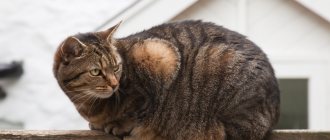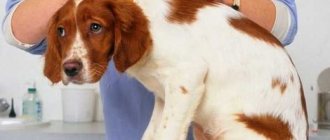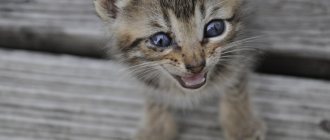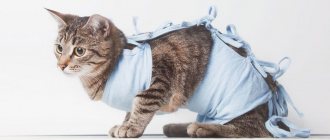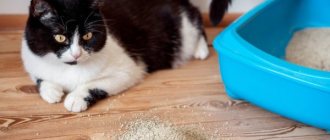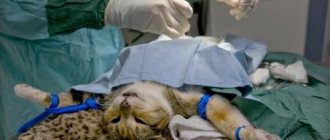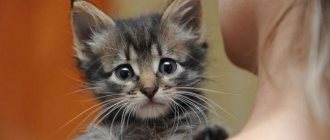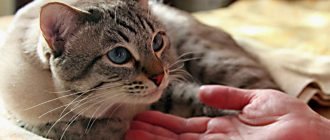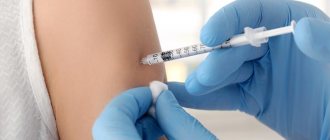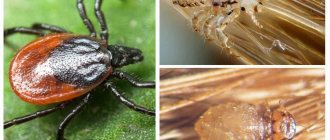Vomiting in a cat after castration: reasons, how to help
The operation itself is not as complicated as pet owners imagine it to be. Castration is the safest surgical procedure. Cats become more obedient, flexible, stop marking their territory, and the smell of urine loses its stench. However, castration does have some minor negative consequences, and you need to be prepared for them. For example, sometimes a cat vomits after castration.
The operation takes place through surgery, under general anesthesia , but there are also chemical methods of castration. To reduce unpleasant consequences and stress, you need to prepare your cat for castration.
How to cook a cat?
Principles of preparation for surgery:
- It is necessary to conduct an examination by a veterinarian and listen to his recommendations during consultation. You should make sure that there are no contraindications to the operation and that the animal is completely healthy. You need to take a urine, blood, and stool test. Contraindications are: cardiovascular diseases, infectious diseases, blood pathologies, urolithiasis, inflammatory diseases of the genital organs.
- If the cat has never been vaccinated or the last vaccination occurred more than a year ago. To undergo surgery, you need to get vaccinated a month before the operation. This is necessary because after a surgical procedure, a weakened body is prone to infection with viral and bacterial infections.
- For the same purpose, deworming . It must be done 1-2 weeks before vaccination. In addition, you need to remove fleas and other blood-sucking parasites. The meaning of the procedure is the same: after the operation, the susceptibility to diseases will increase and the pet’s condition may worsen.
- Depending on what time you are scheduled for surgery, you should be on a fasting diet. If it is for the first half of the day, then the animal does not need to be fed in the evening, usually 12 hours in advance, that is, the last time can be fed at 18:00. This applies to water to a lesser extent, but it is better not to give the cat anything to drink 5-7 hours before surgery. Otherwise, the cat will vomit after castration or right during the operation itself. This is dangerous because during sleep all motor and state-controlling mechanisms are turned off, so the cat can choke on bile.
- If you notice an increase in excitability and nervousness in your pet, then you need to consult a doctor, talk about the behavior, and the veterinarian will examine the pet. It is necessary to make sure that the animal is not a cryptorchid, since in this case the operation must be performed slightly differently. All this needs to be known in advance.
How long does it take for a cat to recover from anesthesia?
Ordinary yard cats and male cats recover from anesthesia faster than purebred cats. Artificially bred animals often have cellular mutations that weaken the immune system. The hardest time is for the British, Siamese, Himalayans, Bengals and Sphynxes.
In addition to breed, age and general health are important. A kitten without pathologies will tolerate the procedure easier than an adult pet with chronic diseases.
On average, wake-up time is 2-8 hours. Restoring for an entire day is acceptable, but is an exception.
The amount of incoming anesthetic is reduced 10 minutes before the end of the procedure. The safest type of anesthesia is gas. It does not settle in the internal organs and completely leaves the body through the lungs during breathing. This drug is recommended for animals with kidney and liver pathologies. It costs more than its injection counterparts, but is superior to them in terms of weathering speed and safety.
In addition to the type, the quantity of the drug is also important. The lowest dosage is used for castration and dental treatment.
Caring for a cat after surgery
When the cat wakes up from anesthesia after a successfully performed operation, he can be taken home. A caring owner should know how to provide comfort to the pet so that recovery after removal of the cat's testes is quick and painless.
To create comfortable conditions, you must perform the following actions:
- Prepare a warm, comfortable place, protected from bright sunlight and drafts. Spread a clean, soft, ironed cotton cloth. If your pet experiences chills, then in such a secluded corner it will be easier for him to cope with the discomfort.
- A temporary rookery must be placed on the floor. The reasons are quite simple - after anesthesia, the animal shows lethargy and coordination of movements is impaired.
- Pay special attention to the tray. Conventional fillers can lead to bad consequences: clogging the postoperative site, injuring the suture. It is recommended to cover the tray with soft toilet paper or pharmacy diapers. Frequent and timely cleaning of the cat litter box is mandatory.
- Make sure you buy a plastic collar at the pet store in advance. To speed up the healing of the castration wound, the suture should remain dry. A special cone will not allow you to lick the sore spot and will prevent complications and infection after surgery.
Using anesthesia for cats
Caring owners are interested not only in how long it takes for cats to recover from anesthesia after sterilization, but also in the possible danger of the event. Unpleasant consequences can be avoided only if all contraindications are strictly observed.
The drugs used in animal anesthesiology have a mild and safe effect. All dosages are selected individually based on the analysis of the mustachioed patient. Before surgery, the veterinarian must check the functioning of the heart to assess possible risks.
Please note that there is always a possibility of death. A doctor’s denial of this fact is a lie that leaves an imprint on his competence. The main task of the anesthesiologist and veterinary therapist is to minimize risks. By taking into account contraindications and choosing the right drug and dose, the likelihood of complications is close to zero.
After anesthesia, the cat’s body is greatly weakened, so additional aggravating factors are detrimental to it. Contraindications for surgical intervention include:
diseases of the respiratory system and heart;
periods of estrus, gestation and feeding of offspring;
age more than 10 years;
pathologies of the genitourinary system in chronic form and viral infections in acute form.
Despite these limitations, they can be neglected. This is acceptable if the animal’s life is at risk and other methods of treatment do not help it - then the risk of surgery fades into the background.
Veterinarians do not recommend using anesthesia more than once a year - if time is of the essence, it is better to postpone the operation or use alternative treatment methods.
Vomiting in a cat as a postoperative complication
Each animal is individual; how the body will behave after castration is unknown to an experienced veterinarian. Sometimes, even with proper care on the first day, postoperative complications arise. One of these negative manifestations is vomiting. If the animal has already recovered from anesthesia, then there will be no problems, but if the cat still cannot stand on its feet, then it needs help.
If the cat is vomiting, you need to make sure that the pet does not choke on the vomit. If vomiting is not severe, turn the animal's head to the side, thereby eliminating the possibility of vomit getting into the respiratory tract. If vomiting is severe, you should call a veterinarian.
Within 2 days, cats may exhibit weakness, lack of appetite, and fever. These signs are normal after surgery. If the temperature drops below 37° or the temperature rises above 39°, as well as the persistence of the above symptoms for 2-3 days, you should contact a veterinary clinic.
When castrating a cat, some negative consequences are possible, for which you need to be prepared and know what to do:
- Vomiting in some cases is considered a consequence of anesthesia , including in the absence of preparation for surgery. If the vomit is not abundant, you simply need to control the process so that the pet does not choke.
- Also sometimes there is an increase in temperature, lethargy and weakness. This situation is natural, especially in the first time after surgery and for 2 days after. But in case of fever (from 39°C) more than 1-2 days after castration, you must immediately consult a veterinarian.
- Internal bleeding in the scrotum. This is indicated by swelling of the scrotum, accumulation of blood in it, which is easily palpable. It is observed only when doctors have sutured surgical wounds. Typically, internal bleeding is very dangerous due to the fact that it is impossible to assess the pet’s condition. If your cat experiences weakness or pale mucous membranes, you should immediately contact a veterinarian.
- Wound infection. Redness of the skin, the presence of swelling, pathological exudate from the wound (green, yellow, white, thick consistency, with an unpleasant odor) - all this indicates an infection, you need to consult a doctor. The presence of small red spots and slight swelling may also indicate an infectious disease; it is better not to risk it and seek advice.
- Obesity is the most common problem. After castration, a cat needs 25-30% less calories. In this case, the pet will demand more food than it really needs. So the responsibility falls on the owner to regulate the animal’s diet. It is recommended to purchase special food for neutered cats or switch to natural food. All this must be done after the suture has been removed and the surgical wound has healed.
How to prepare an animal for surgery
Most complications that appear in the postoperative period are associated with a sharp drop in immunity. To preserve the body's defenses, it is important to prevent any pathological conditions that could harm the pet.
Most often, operated patients become infected with worms and viruses, so treatment against parasites and vaccination are prerequisites for operations under general anesthesia. An anthelmintic is given 1.5 weeks before the procedure, and the vaccine is administered no later than a month.
If vaccination is missed according to schedule, then a serum injection is used. It gives similar results in a shorter time - within 2 weeks.
A couple of days before the operation, the blood and urine of the future patient are checked for possible deviations. To calculate the volume of anesthesia, indicators obtained on ultrasound and x-ray of the respiratory and cardiac organs are taken into account.
Half a day before the start of the operation, the cat should not be fed, and 3 hours before the operation, the cat should not be given water. The absence of solid and liquid food prevents the occurrence of nausea, which can lead to pneumonia due to aspiration of vomit.
General information
As you know, castration in most cases refers to an operation to remove the testes of a cat. Of course, there are less traumatic options when the testicles are preserved, but still in 90% of cases they are cut out. The operation itself is extremely simple and rarely requires full anesthesia. But in recent years (mainly for humanitarian reasons), even in this case, general anesthesia is increasingly used. It is not surprising that after recovering from anesthesia, a cat may vomit. This phenomenon is not absolutely normal, but it also does not pose any particular danger.
Very often, vomiting in a cat after castration is a consequence of gross non-compliance with the basic rules of preparation for surgery:
- The animal must not be fed at least 12 hours before the procedure. Ideally, this period is immediately increased to 16 hours.
- Two to three hours before surgery, the cat must not be given water.
- It is strictly forbidden to perform castration in cases where the pet is sick with something (this also includes severe cases of helminthic infestations).
In addition, immediately after recovery from anesthesia, your pet should not be given water (at least three hours later), and there is no talk of food at all!
You should wait about 12 hours, and only then start feeding the hungry cat. And this must be done using liquid broths. It is believed that a pet can be returned to its normal diet only after a few days. This way, his body is guaranteed to recover from the effects of anesthesia.
If you immediately give meat in pieces on the 2-3rd day, you shouldn’t expect anything good. The animal’s digestive system is still “inhibited” at this time, and therefore not only vomiting, but also diarrhea may develop. And all because the food will be poorly digested and will begin to rot, resulting in intoxication.
Why does a cat vomit after castration?
We all know very well that everyone - human or animal - has individual characteristics that make our body unique among those similar to it. And the response in various situations - everyday or stressful - will also be strictly individual. Therefore, even the most experienced veterinary surgeons cannot guarantee that after the operation your cat will be “like a cucumber” within so many hours. Even with the most favorable course of the operation, postoperative complications may arise immediately, on the first day, which they could not even think about. And one of them is vomiting. If by the time it starts, your pet has recovered from anesthesia and can move normally, this will not be a problem. But if the cat cannot stand on its feet, then you need to constantly be nearby and control the situation so that it does not choke on vomit. And if necessary, invite a specialist.
General information about the causes of vomiting
From the point of view of veterinary practice, the term “castration of a cat” is an operation to remove the testicles (testes) of an animal. Of course, this operation can be replaced with another option, when the spermatic cords are ligated and the testicles are preserved, but still, both owners and veterinarians in 90% of cases prefer to remove them in order to change the cat’s behavior.
Castration itself does not require mandatory general anesthesia, but now, mainly for reasons of humanity, it has begun to be used everywhere. It is the use of this method of pain relief and subsequent recovery from it that leads to vomiting in domestic cats. In principle, vomiting, of course, cannot be called an absolutely normal response, but this is not critical.
Most often, vomiting, as a complication after castration, occurs when the following rules for preparing the animal for surgery are not followed:
- Starvation diet:
at least 12 hours, and preferably 16 hours before the operation, the animal is stopped giving food (in this case, it is necessary to clearly explain to family members why your pet cannot be fed at all), but a bowl of water is left. - Dry diet:
2-3 hours before surgery, stop giving water. - Healthy animal:
the operation CANNOT be performed on a sick animal (based on general condition and test results). - Carrying out deworming:
the operation is IMPOSSIBLE if there are helminths (worms) in the cat’s body.
It very often happens that an animal has just come out of the effects of anesthesia, but has not come to its senses, and it immediately gets a hundred pleasures: “Go get a drink!” Let’s eat!” Doing this is strictly prohibited. You can give water at least 3 hours after your pet has recovered from anesthesia, but feed it for the first time after 12 hours. And then, you need to give it not tastier meat, but liquid broth. It will be possible to switch the cat to a regular diet only after 2–4 days. This extended transition will help the family pet to better recover from the anesthesia used during the operation.
Important for owners:
If you give your cat meat 2-3 days after the operation, his body, “inhibited” by the drugs, will not be able to completely process and assimilate the food, the pieces may begin to rot in the animal’s stomach and, as a result, intoxication will develop. Before that, vomiting and diarrhea will appear. Therefore, on the first day, do not give your purr any “heavy” food. If you really want to pamper a “convalescent” animal, buy at a pet store special food for sick and weakened animals, for example some kind of pate.
It often happens that during surgery it is necessary to insert a special (endotracheal) tube into the trachea, which will allow air to move freely through the respiratory organs of the animal. If for some reason the insertion of the tube was not done very carefully and “passed” along the walls of the trachea, the cat will definitely develop a “barking” cough due to a strong sore throat and then vomiting appears. I think you are familiar with this cough.
Other factors that contribute to vomiting
In addition to improper preparation for the operation and the problems of postoperative complications, multiplied by the owner’s desire to please the unfortunate sufferer, other factors can be identified that can cause vomiting in a cat after surgery:
- If your cat quickly recovers from anesthesia, is cheerful and cheerful already on the first day, that’s great. However, one very significant “but”
: the purr can begin to actively lick the part of the body that was “damaged” during the operation. There will be powder or something else in its cavity. The surface of the wound is smeared with levomekol and if your pet has “removed” all the drug, then vomiting is guaranteed, although it will probably not be the biggest problem. The thing is that by licking the wound, your cat can introduce an infection into it, which in turn can become the basis for suppuration and sepsis.
Note to owners:
sepsis develops in animals with a weakened immune system (for example, after surgery) and from a source of inflammation/suppuration - a wound on the scrotum; the products of this very process easily enter the bloodstream and spread throughout the body, causing the death of the animal.
To prevent this from happening, put a protective collar on your cat, which you can buy at a veterinary pharmacy or make yourself.
- At the time of the operation, you “continued” the need to deworm the cat and went to the clinic for a planned operation. In this case, it is possible that the toxins secreted by the worms may interact with anesthetic drugs.
- Out of the kindness of your heart, you fed your pet “to the full” before the operation, unable to withstand the reproach of your pet’s hungry eyes, or as soon as he came out of anesthesia. Such “kindness” can lead to vomiting associated with intestinal volvulus and the death of the tailed friend.
The cat vomits after sterilization.
The cat is 6.5 months old, she began to ask for a cat - on December 3, she was spayed (castrated). On December 5th and 7th there was vomiting, it looked like a mush from the food, yellowish (he eats Royal Canin for kittens). What do you say, should I run to the vet or will it go away?
Woman.ru experts
Find out the opinion of an expert on your topic
Kachkacheva Maria Mikhailovna
Psychologist. Specialist from the site b17.ru
Fedor Erokhin
Psychologist, Arranger Clinical psychologist. Specialist from the site b17.ru
Olga Samokhvalova
Psychologist, Emotional-imaginative therapy. Specialist from the site b17.ru
Yakovleva Oksana Aleksandrovna
Psychologist, Consultant. Specialist from the site b17.ru
Maksimov Sergey Vyacheslavovich
Psychologist, Online consultant. Specialist from the site b17.ru
Spiridonova Nadezhda Viktorovna
Psychologist. Specialist from the site b17.ru
Zubkova Anna Andreevna
Psychologist, Gestalt therapist. Specialist from the site b17.ru
Nevzorova Sofya Igorevna
Psychologist. Specialist from the site b17.ru
Tsvetaeva Lara Alexandrovna
Psychologist, Online consultant. Specialist from the site b17.ru
Shakhova Alisa Anatolyevna
Psychologist. Specialist from the site b17.ru
Did you at least get spayed during estrus? You can’t do it during heat, you have to wait it out.
Vomiting is normal within 24 hours after surgery. Now, if the vomiting is one-time, then observe for a couple of days, if several times a day, then see a doctor. It’s better not to feed dry piano, it’s now produced in Russia, and the quality has dropped greatly.
author, sterilize yourself, go *** torture animals
intoxication from anesthesia, you need to drink well and eat different food. well, like porridge, sour cream. thinner.
Due to anesthesia, apparently, the body’s reaction. For now let's just have some water
author, sterilize yourself, go *** torture animals
Related topics
Author, I worked in a veterinary clinic, vomiting is an absolutely normal phenomenon in the first 24 hours after surgery, if the cat is weak, weighs little, maybe the anesthesia was overdone, then it may take longer. It was necessary not to give any food at all except water for the first 1-1.5. The cat should lie in a warm place, then slowly be given soft food such as whiskey, maybe unsalted broth. solid food only after complete recovery. You can call the doctor who performed the operation and ask about anesthesia. I think he was too strong.
Anyone who is planning to sterilize, always tell the doctor to inject a minimum of anesthesia, and not a heavy dose, which can lead to death
I forgot to add: 3 days after the operation, on the recommendation of the vet, I was given liquid painkillers, which the vet gave, and in the dosages indicated by the vet. Today, December 8th, there has been no vomiting yet. The cat ate mostly pate.
We recommend reading: Hot Dog Shivering Stinky Mouth Sleeping All The Time
Did you at least get spayed during estrus? You can’t do it during heat, you have to wait it out.
It’s better not to feed dry royal, it’s now produced in Russia, the quality has greatly decreased.
Author, I worked in a veterinary clinic, vomiting is an absolutely normal phenomenon in the first 24 hours after surgery, if the cat is weak, weighs little, maybe the anesthesia was overdone, then it may take longer. It was necessary not to give any food at all except water for the first 1-1.5. The cat should lie in a warm place, then slowly be given soft food such as whiskey, maybe unsalted broth. solid food only after complete recovery. You can call the doctor who performed the operation and ask about anesthesia. I think he was too strong.
Thank you all very much for your answers! I hope the cat recovers soon
Hello. And if after 5 hours after the operation, she vomits from water. This is fine?
Ours was normal, on the 7th day it vomits greens, we give it smecta, we’ll take it to the doctor tomorrow, there are no experienced veterinarians, the town is small, even if it’s in the regional one, the cat is lying in a very bad state.
The cat eats very poorly after sterilization and almost everyone vomits. What to do? What's wrong with her we can't understand. Although there were cases that she was vomiting even before the operation.
Today I sterilized my cat, after anesthesia she suddenly jumped high on the sofa, I’m afraid that the stitches will come apart
Moderator, please note that the text contains:
The complaint has been sent to the moderator
The page will close automatically after 5 seconds
New in three days
Popular in three days
The user of the Woman.ru website understands and accepts that he is fully responsible for all materials partially or fully published by him using the Woman.ru service. The user of the Woman.ru website guarantees that the placement of materials submitted by him does not violate the rights of third parties (including, but not limited to copyrights), and does not damage their honor and dignity. The user of the Woman.ru site, by sending materials, is thereby interested in their publication on the site and expresses his consent to their further use by the editors of the Woman.ru site.
Use and reprinting of printed materials from the woman.ru website is possible only with an active link to the resource. The use of photographic materials is permitted only with the written consent of the site administration.
Posting intellectual property objects (photos, videos, literary works, trademarks, etc.) on the woman.ru website is permitted only to persons who have all the necessary rights for such posting.
Copyright (c) 2020-2020 Hirst Shkulev Publishing LLC
Online publication “WOMAN.RU” (Zhenshchina.RU)
Certificate of registration of mass media EL No. FS77-65950, issued by the Federal Service for Supervision of Communications, Information Technologies and Mass Communications (Roskomnadzor) on June 10, 2020. 16+
Founder: Limited Liability Company "Hirst Shkulev Publishing"
Ours was normal, on the 7th day it vomits greens, we give it smecta, we’ll take it to the doctor tomorrow, there are no experienced veterinarians, the town is small, even if it’s in the regional one, the cat is lying in a very bad state.
The first hours after surgery
If the cat was castrated in a clinic, then the pet must spend the first hour there. This is the most difficult moment: the animal comes out of anesthesia, and the veterinarian must make sure that everything happens according to plan - no complications are observed.
The second and third hours spent at home are still quite difficult. The cat has general weakness and dizziness. He is most likely thirsty, but also feels nauseous. And what is most important to a pet now is the love and attention of its owner.
Key points to pay attention to at this time:
- Drying of the ocular conjunctiva. During the operation, the pet's eyes remain open. The doctor regularly moistens them using special drops. At home, this procedure should be done by the owner, placing tetracycline ointment or a special “Diamond Eyes” solution under the cat’s eyelids.
- Decrease in temperature. Most likely, at first it will remain at 37 °C, which is two degrees below normal. Your pet may experience mild tremors from time to time. Therefore, it is better to place it in a warm place and cover it with a blanket. As a last resort, you can use an electric heating pad in a case or a hot water bottle wrapped in a towel.
- Impaired coordination of movements. Due to high muscle weakness, when trying to stand up or walk, the cat may stagger from side to side. It is better to try to persuade him to lie down with gentle persuasion. This will pass in a couple of hours, now the main thing is to make sure that your pet does not fall, especially from a height.
- Refusal to eat. The cat is unlikely to develop an appetite in the first hours. Abstinence now is only good for him. Otherwise, vomiting may begin.
- Painful sensations. It is advisable to ask your doctor in advance what painkillers you can use. Signs that a pet is suffering may include dilated pupils, pursed paws, and aggression when attempting contact.
The first signs of awakening
The first hours after anesthesia, the cat remains in the hospital. At this time, doctors monitor their cardiac activity to exclude complications and promptly provide first aid if necessary.
The pet is handed over to the owner only after complete awakening. In the first day you will have to constantly look after him, since, in addition to drowsiness, there is a lack of coordination.
After returning to normal conditions, the animal will try to get up to walk around the room. Moving paws will shake confidence in safety. A frightened cat may become aggressive. You should not try to help her if the actions taken do not threaten her safety.
Over time, aggressive behavior gives way to apathy. The animal crashes into the walls, falls out of the blue and has difficulty holding its head up. In this state, he really needs the moral support of his owner. Talk to him in a soft voice and stroke him to relieve any fear and tension that has arisen.
During abdominal operations, a special blanket is put on the animal. This prevents him from licking the wound and protects him from the seams coming apart. Sometimes a special cone collar serves this purpose.
The anesthetic lowers body temperature and prevents free blinking. At first, the cat will be cold and will not be able to close its eyes. Every half hour she will have to instill eye drops to protect her mucous membranes from drying out.
Set up a comfortable and warm place on the floor, covering it with a disposable diaper - the animal may wet itself. Make sure your pet doesn't jump. Due to poor coordination, she may fall and get hurt. In case of severe weakness, it is better to place your pet on the right side. This will make the heart work easier.
When protecting your cat from the cold, do not go to extremes. Using a heating pad and heating devices is fraught with the development of an inflammatory process. If your pet is trembling, cover it with a blanket. Try to keep children and other pets away from it. In a calm environment, the cat's behavior will be more appropriate.
In case of prolonged apathy and lack of physical activity, check the reaction to stimuli:
Open your pet's eyelids. When exposed to sunlight or artificial light, the pupils should contract.
Blow gently into your ear. Feeling the flow of air, the pet should move its ear.
Make a clap over the animal's head. It should flinch in surprise.
If the reaction is positive, then just be patient. You should consult a doctor only if your pet does not respond to any of the stimuli.
Treatment of the surgical wound
During the first two weeks, the surgical area must be inspected regularly and checked to avoid bleeding or infection of the wound.
During the first week, to speed up the healing of the stitches, they should be treated with hydrogen peroxide twice a day and smeared with a solution of brilliant green. Later you can use iodine. In case of the slightest redness, you can lubricate the surgical area with Levomekol.
To prevent the cat from injuring the operating area, it is better to put a special collar on him for the first days. Otherwise, as a result of licking, the seams may come apart.
It is better to do the operation in winter or autumn. During this period, the likelihood of wound infection is less. During the summer, your veterinarian will usually prescribe a course of antibiotics for at least five days.
As soon as the cat begins to stand up, it is necessary to place a litter tray with low sides near the bed. It is better to add a filler (silica gel is better, it does not create dust and dirt) that is light in color, so that you can immediately see if there is bleeding or pus.
If this is necessary, then on the first day you can use special diapers for cats.
If the cat avoids the toilet in the first days, this is understandable. Firstly, he had hardly eaten or drunk anything yet. Secondly, he experiences pain and discomfort and delays this moment. As a last resort, you can give your pet a little Vaseline oil.
It’s also okay if the cat goes to the toilet in small portions. This is normal for the first days. Within a month everything should be back to normal. And, most importantly, the urine will no longer have a pungent odor.
Cat nutrition after castration
In the first hours and days, due to the effects of anesthesia and pain, the cat will not have time to eat. The main thing is not to force your pet to eat, this will only irritate him once again. Clean and fresh water should always be nearby. As soon as the nausea passes, the cat will quench its thirst.
Soon your appetite will return and, most likely, it will be increased. Overeating should not be indulged. Changes in hormonal levels can easily lead to obesity and related diseases. But if the cat refuses to eat two days after the procedure, this is an alarming factor. You need to contact a veterinarian.
As for the diet, it is better to gradually switch to special food for neutered cats or preventive food to prevent urolithiasis. If your pet is on a natural diet, remove fish and any food excessively enriched with calcium, phosphorus, and magnesium from the daily diet.
Dry food causes acidification of urine, which is also a prevention of urolithiasis, so this diet should be preferred. But drinking should always be plentiful. Read more in the article on what to feed a neutered cat.
Aftercare
The likelihood of injury or other complications under constant supervision is reduced to almost zero. For the safety of your mustachioed pet, take a few days off or vacation during the postoperative period.
Drinking on your own is prohibited for the first 3-4 hours. Due to a violation of the swallowing reflex and severe drowsiness, the pet runs the risk of choking while swallowing or involuntarily falling asleep right in the bowl.
Wait until the stiffness disappears and the animal can hold its head up on its own. Until this time, feed him in small portions through a pipette or syringe without a needle. This will protect against dehydration and drying out of the mucous membranes.
If fluid loss is unacceptable, then fasting on the first day is quite acceptable. Wait until the animal has completely recovered from the anesthetic and shows interest in food.
With the return of coordination, offer your pet liquid dishes (broths, watery cereals). Such light meals are digested faster, helping to avoid constipation. You will have to temporarily stop dry feeding. If your pet is not used to regular food, then use pouches and canned soft food.
The temperature of the food should be at room temperature. It is useful and safe for the gastric mucosa. The frequency of feedings will have to be increased and portions reduced. You need to return to your usual regimen and volumes very smoothly to avoid stress on the gastrointestinal tract.
On average, it takes 7-10 days for wounds to heal. Until this time, you will have to protect them from damage, getting wet and suppuration. The seams must be dry and clean, so additional processing is best avoided. The use of ointments and other drugs in liquid form inhibits regeneration and is only permissible as prescribed by a veterinarian.
Due to the loss of control over defecation and urination in the first hours and even days, the pet may walk under itself. Be sure to put moisture-resistant diapers in the bed and change them immediately after bowel movements.
During the entire rehabilitation period, there should be a tray next to the bed. With poor coordination, it is very difficult to relieve oneself accurately, so searching for a toilet will only make the situation worse. Temporary difficulties will disappear when sensitivity returns to the hind legs.
Quarantine will have to be observed for at least 14 days. There are many dangers on the street: ticks, viruses, bacteria, helminths, fleas. Infestation with parasites or infection can lead to inflammation of the wound and deterioration of the general condition.
The risk of infection at home is lower, but still remains. For prevention, the animal is sometimes given 2 injections of antibiotics. The first is done at the end of the procedure, and the last - two days later.
Mr. Cat recommends: possible complications
Typically, recovery after castration proceeds calmly, without deterioration of the condition. But you need to be aware of what cases may occur and be prepared for them.
Complications can be early or late.
Their first signs may appear on the operating table. They are expressed in bleeding and prolapse of the omentum or testes - the organs closest to the operating area. Good recovery care will help resolve this problem quickly.
Late complications are most often associated with wound infection. There may be several reasons - unsterile instruments, poorly treated surgical area, violations in postoperative care.
Symptoms that should cause concern to the owner:
- Increase in body temperature by more than two degrees above normal.
- Change in gait. They often say that the cat is experiencing pain and discomfort.
- Refusal to eat, apathy for several days.
- Increased thirst or refusal of water.
- Nasal discharge, sneezing.
- Pain when palpating the operating area.
- The cat has difficulty going to the toilet.
- Discharge from the wound in the form of pus and ichor.
- The pet's heavy breathing, shortness of breath, arrhythmia and tachycardia.
It is necessary to immediately contact the surgeon who operated on the cat and tell him about the alarming symptoms.
The most common complication, but nevertheless rare, is inflammation of the scrotum and surrounding tissues. If your pet has cryptorchidism, then this pathology is much more difficult for them to tolerate. Since the castration procedure itself was more difficult, because with this phenomenon the testes do not descend into the scrotum, and the operation becomes essentially cavitary. Usually the recovery period in this case is longer.
Important rules for owners
Additional recommendations that the owner of an operated cat must follow:
- If your pet used to walk outside, then during the week he is strictly prohibited from walking. So are active games. The main thing now is to preserve the postoperative sutures and prevent them from coming apart and becoming infected.
- Be sure to use an Elizabethan collar to limit licking of the operating area. You will have to wear it for at least a week. If your pet repeatedly tries to remove it, you should consult a veterinarian; you may have to use sedatives. When using them, the cat will almost always sleep.
- Some experts advise that in the first days, remove the litter from the toilet altogether and put shredded toilet paper in it (it is strictly forbidden to use newspapers for these purposes). This measure can prevent infection of the surgical suture and the canal itself.
- You should not bathe your pet for one to two weeks after surgery.
- During the first two days, the cat may experience pain. If the period of suffering drags on, this is an alarming sign; a hematoma or inflammation may develop. It is necessary to urgently consult a veterinarian.
Causes of illness
Every cat periodically burps its fur. The problem can also occur in hairless breeds adjacent to furry pets. When licking, hair accumulates in the cat's gastrointestinal tract and needs to be released. Do not be alarmed if your cat periodically (1-2 times a week) burps dense hair sausages or balls. Problems are indicated by more frequent vomiting, constipation, lack of appetite, depression and bloating. Symptoms indicate that the stomach and intestines are full of wool.
List of reasons why vomiting in a cat is provoked:
- Poor nutrition. This does not only mean food. Kittens and adults show interest in non-food items such as broomsticks, houseplants, decorative items (such as ikebanas), foil, or Christmas decorations. Some enter the body accidentally during play, others are eaten deliberately. Vomiting of undigested food is a potential sign that the selected food or some product in the diet is not suitable for your pet.
Overeating. A large portion or rapid swallowing of food does not allow the stomach to completely digest it, as a result, the food comes back through the mouth.
Pregnancy. The space for the stomach decreases during pregnancy. Hormonal changes also contribute to nausea.
Age. Problems with food absorption are observed in kittens during the transition to solid food. Vomiting can also be caused by a congenital abnormality of the gastric sphincter, due to which the entire amount of food eaten cannot pass into the intestines. Active games a short time after eating are also a potential cause of malaise. Elderly individuals also suffer from a reflex eruption of gastrointestinal contents, whose body, due to age, is less able to process food.
Poisoning. Stomach cleansing (including diarrhea) is the body's standard defense mechanism when confronted with a toxin. In such cases, pets often feel sick after each meal, their appetite decreases, an aversion to food appears, and a general deterioration in their condition is observed.
Stress. Emotional overload can cause involuntary contraction of the stomach muscles.
Reaction to medications. Involuntary stomach contractions are a side effect of taking a number of medications. Veterinarians who prescribe treatment or instructions usually warn about it. Nausea is also observed after general anesthesia. If the animal vomits shortly after surgery, it means that it has not yet recovered from anesthesia.
Infection. Bacterial and viral infections, such as plague and hepatitis, directly or indirectly affect the functioning of the stomach.
Parasites. Helminths of various types are a common cause of vomiting.
Injuries. Regurgitation of food is caused by damage to the larynx, stomach or intestines. It can be caused by injuries to the brain and other internal organs.
Various pathologies. Vomiting is a possible companion to oncology, liver, kidney and gallbladder diseases, gastritis, pancreatitis and other disorders.
Vomit differs in volume and composition:
- If a cat vomits saliva or a white foamy substance, which is protective stomach mucus, then the animal is vomiting on an empty stomach.
Too dry mass may indicate dehydration.
The color of vomit depends largely on what you eat; greenish, reddish or yellowish substance may be stained by the feed.
Bile and blood will always stand out against the background of food shades. Their presence indicates a serious violation.
The presence of excrement will also indicate a dangerous pathology. This is a sign of intestinal damage.
The mentioned cases of obvious illness require immediate contact with a specialist.
To accurately determine the cause, you will need the help of a veterinarian. The doctor will be able to take initial measures to alleviate the patient’s condition and schedule further treatment in a hospital or at home. In less severe cases, the owner's independent help may be sufficient.
The whole truth about Vomit
In cats, the center of the brain responsible for the gag reflex is well developed, so cat owners experience vomiting in their pets more often than owners of other animals.
We recommend reading: How to Treat Scabies in a Dog
Its mechanism is simple: with the simultaneous contraction of the abdominal muscles and diaphragm, a sharp increase in intra-abdominal pressure occurs and the contents of the stomach are ejected through the esophagus onto ... whatever turns up (according to one clearly working law, this is usually a favorite blanket or a light carpet :-)). Vomit is partially digested food, soaked in gastric juice and sometimes tinted with bile. Therefore, they have a sour odor and a yellowish tint.
Vomiting is a protective reaction that helps rid the gastrointestinal tract of foreign objects, poisonous or toxic substances, as well as an excessively large volume of food swallowed at once.
In addition, the gag reflex can be caused by chronic diseases, increased intracranial pressure, effects of the vestibular apparatus (nausea from motion sickness), irritation of certain parts of the body (pharynx, peritoneum, bile ducts, etc.), increased pressure in the stomach and duodenum.
Thus, vomiting is a universal symptom that can mean anything from a simple “can’t do it anymore” to a sign of a serious illness.
"Normal" vomiting
It is common for carnivores (which include cats) to regurgitate semi-digested food from their stomachs to their young during their transition from milk to meat. The still fragile digestive system of babies more easily assimilates food prepared and disinfected by the mother’s gastric juice. This ancient feature sometimes appears in domestic cats. True, sometimes they themselves do not understand why they need this instinct and how to use it, because a kind owner will bring the necessary (i.e. tender) food to the kittens.
Source
Our special offer for Moscow residents! Castration of a cat at home costs only 3,000 rubles! The price includes a veterinarian's visit, anesthesia, castration of the cat, medications and consumables.
Comprehensive service for sterilizing cats at home. The price includes medications, consumables, doctor's work and post-operative bandage.
Our special offer for Muscovites to vaccinate dogs and cats! Complex rabies vaccination at home - 2300 rubles! The price includes a home call from a veterinarian, an examination, the cost of a vaccine and the doctor’s work.
Treatment of vomiting in pets
In case of poisoning, it is important to block the action of the toxin, for which sorbents are used. It is most convenient to use suspensions like Phosphalugel - the dose is taken at the rate of 0.5-1 drug per kilogram of the cat’s weight. If the animal’s condition does not improve after using sorbents (after 2-3 hours), or there is a suspicion that a specific poison has been consumed, you should immediately take it to the veterinarian. Clinics have antidotes to some toxins that can save your pet or speed up its recovery.
It is important to eliminate the root cause of the malaise. Injuries and tumors usually require surgery. If a concussion occurs, the cat will need complete rest, isolation from other pets and irritants. For the corresponding conditions, antibacterial, antiviral, oncological or antiparasitic drugs, immunostimulants and vitamin complexes will be needed.
All these remedies are selected and prescribed by the doctor. He also decides to administer an antiemetic. For cats, Cerucal or No-shpu is used - intramuscular injections in a volume of 0.1 ml per 1 kg of weight. You should not prescribe injections yourself.
The exception is the case if the pet is very sick (every day or several times a day), there is no opportunity to show it to a specialist, and gentle methods did not help. There are also folk remedies. So, it is suggested to treat a cat with a decoction of flaxseed: the liquid is given 1-4 tablespoons (depending on the size of the patient) 3-4 times a day.
What to do when the danger has passed
Help with vomiting includes depriving the pet of food and water (at least for 4-5 hours). Liquids need to be returned to the diet faster than food; It may be worth starting with an IV to replace the loss without irritating the stomach. Subsequently, the cat should always have access to water. For the first 2-3 days, the animal must be on a gentle diet: special food, rice water, lean boiled chicken or other light food. Raw foods, even if the pet has consumed them before, are excluded. Feed, due to its attractive smell, can be a more effective solution if the animal does not eat anything.
A cat's vomiting with foam, greenish or yellow color, undigested food or inedible swallowed objects does not necessarily mean there are serious problems with the body. The problem is often solved by adjusting the diet. But frequent attacks, general deterioration of the animal’s condition, the presence of blood or bile in the discharge require the involvement of a veterinarian.
The doctor will determine the root cause of the ailment and prescribe appropriate treatment. Regardless of the disease, in case of involuntary contractions of the pet’s stomach, the pet is transferred to moderate feeding of light foods.
Preventive measures
The easiest way to solve the problem of overeating or poor nutrition. At home, the cat needs to limit access to his favorite inedible “treats” as much as possible. It will be more difficult to monitor pets walking on the street - the owner will have to rely on their sanity.
If the animal is constantly drawn to dry or live plants, you should provide it with a suitable source of vitamins in the form of, for example, wheat germ. You need to choose the right type and dosage of food based on the age, health and preferences of your pet. Access to water is not regulated - the pet should always have fresh liquid in its bowl.
